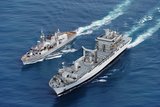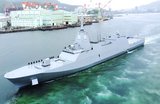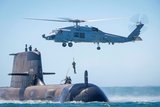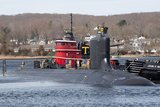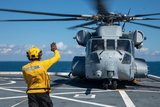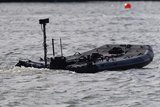USS John F Kennedy on schedule
Huntington Ingalls Industries’ (HII) Newport News Shipbuilding division has placed a 900-ton superlift into dry dock as part of construction of the future USS John F Kennedy (CVN 79), the second Gerald R Ford-class aircraft carrier for the US Navy, the company announced on 12 September.
According to HII, the ship’s cost and construction schedule is on track, with CVN 79 set to be completed with 445 superlifts.
Mike Shawcross, Newport News’ vice president, CVN 79 carrier construction, said: ‘The incorporation of lessons learned from CVN 78 on to CVN 79—and major build strategy changes to construct the ship a different way—are having a significant impact on our construction efficiencies.’
The ship is built using modular construction, where smaller sections are welded to form larger structural units called superlifts. The equipment is installed in these units, which are then lifted into the dry dock with the company's 1,050-metric ton gantry crane.
Mike Butler, Newport News’ Kennedy construction programme director, said: ‘Fewer lifts to the dock means we’re building larger superlifts with more outfitting installed prior to erecting the sections in dock. This translates to man-hour savings because the work is being accomplished off the ship in a more efficient work environment.’
Since the ship’s keel was laid in August 2015, almost 90 lifts have been placed in the dock and joined together. CVN 79 is scheduled to be launched in 2020 and delivered to the US Navy in 2022. It will be replacing the supercarrier USS Nimitz (CVN 68).
More from Naval Warfare
-
![Hanwha wins Australian government approval to increase its stake in Austal]()
Hanwha wins Australian government approval to increase its stake in Austal
The contract would mean the two shipbuilders can collaborate strategically and enhance shipbuilding capabilities in Western Australia.
-
![Royal Australian Navy sizes up modernisation plans for new and existing capabilities]()
Royal Australian Navy sizes up modernisation plans for new and existing capabilities
The Australian navy is pushing ahead with its efforts to modernise its workforce and capabilities while balancing risky submarine upgrades, ageing Collins-class boats and a shrinking minehunter fleet. Head of navy capability RAdm Stephen Hughes updated Shephard on the force’s progress.
-
![UK to join US Navy’s Virginia-class submarine assembly effort to speed up construction]()
UK to join US Navy’s Virginia-class submarine assembly effort to speed up construction
The expansion of the Virginia-class submarine construction to UK shores could accelerate the project as US shipbuilders continue to fall short of delivery goals.
-
![US Navy seeks new sensors for the CH-53K King Stallion heavy-lift helicopter]()
US Navy seeks new sensors for the CH-53K King Stallion heavy-lift helicopter
The US Navy intends to publish a draft request for proposals in Q2 2026 and conduct an open competition for the supply of new electro-optical and infrared capabilities for the CH-53K heavy-lift helicopter.
-
![What new technologies could be involved in UK Atlantic Bastion initiative?]()
What new technologies could be involved in UK Atlantic Bastion initiative?
As new details emerge on the UK Royal Navy’s plan to secure the North Atlantic for the UK and NATO, three main areas of opportunity for new technology are the focal point.
-
![NATO naval exercises map out future USV requirements but raise questions on acquisition]()
NATO naval exercises map out future USV requirements but raise questions on acquisition
Uncrewed surface vessels have shifted from a desirable capability to a critical one for navies. But should these systems be bought outright, rented as a service or rapidly built using commercial off-the-shelf components?








